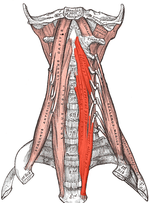Longus colli muscle
| Longus colli muscle |
|---|

|
| ventral neck muscles of humans (Musculi longi colli colored red) |
| origin |
| Pars obliqua superior: - (Tubercula anteriora of the) transverse processes of the cervical vertebrae 3 to 5 Pars recta: Pars obliqua inferior: |
| approach |
| Pars obliqua: - (Tuberculum anterius of the) Atlas Pars recta: Pars obliqua: |
| function |
| Unilateral: Lateral flexion and rotation of the cervical spine to the ipsilateral side Bilateral: |
| Innervation |
| Ramus ventralis of the first cervical nerve |
| Spinal segments |
| C1 |
The musculus longus colli , also called musculus longus cervicis (from Latin musculus "muscle", longus "lang", collum "neck" or Greek kerbikárion "head holder "), in German long neck muscle , is a striated muscle ( skeletal muscle ), which runs on the ventral part of the cervical spine between the first cervical vertebra (the atlas ) and the third thoracic vertebra. The muscle can be divided into three parts:
- Pars obliqua superior musculi longi colli : origin of the anterior tuberosity of the transverse processes of the cervical vertebrae 3 to 5, insertion of the anterior tuberosity of the atlas
- Pars recta musculi longi colli (lies between the other two parts); Origin of the fronts of the cervical vertebrae 5 to 7 and fronts of the thoracic vertebrae 1 to 3, attachment of the fronts of the cervical vertebrae 2 to 4
- Pars obliqua inferior musculi longi colli : origin anteriorly of the thoracic vertebrae 1 to 3, insertion tubercula anteriora of the transverse processes of the cervical vertebrae 5 and 6.
The blood supply is via the artery cervical ascending , vertebral artery , deep cervical artery and artery intercostal suprema .
function
The longus colli muscle, isolated on one side, causes flexion to the side of the active muscle and rotation (twisting) of the cervical spine when it contracts . With bilateral contraction it leads to a ventral flexion (bending forward) of the cervical spine.
Clinical significance
The muscle is often injured by whiplash injuries, most of which are caused by car accidents.
Some scientists attribute the faulty lordosis in whiplash patients to injuries to this muscle.
literature
- Michael Schünke , Erik Schulte , Udo Schumacher : Prometheus. Anatomy Learning Atlas. General anatomy and motor system . 4th, revised. and exp. Edition. Thieme, Stuttgart 2014, ISBN 978-3-13-139524-5 .
- Lexicon of Medicine . 5th edition. Hoffmann-La Roche ( tk.de ).
Individual evidence
- ^ Bernhard Tillmann : Atlas of the anatomy . 2nd Edition. Springer-Verlag, 2010, ISBN 978-3-642-02680-5 , p. 567.